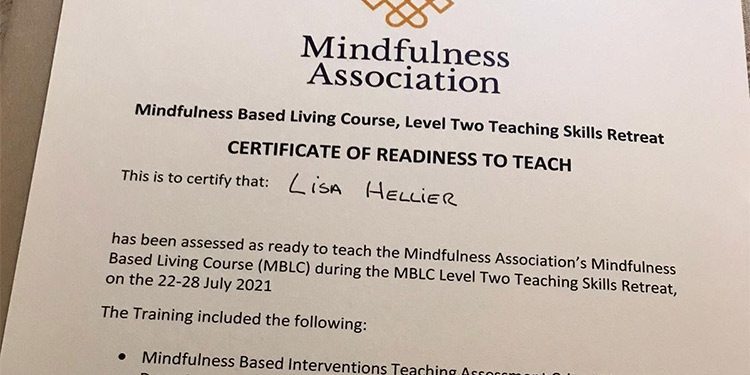TRAINING TO TEACH MINDFULNESS – THE MBLC RETREAT
Meditation is not a matter of trying to achieve ecstasy, spiritual bliss, or tranquillity,
nor is it attempting to become a better person.
It is simply the creation of a space in which we are able to expose and undo our neurotic games,
our self-deceptions, our hidden fears and hopes.
-Chogyam Trungpa
The whole process that has brought me to this blog today, having survived the MBLC Teaching Reatreat (Mindfulness Based Living Course devised by Choden and Heather Regan-Addis) was driven by not a burning desire to become a teacher of Mindfulness, but a desire to deepen my understanding of the processes involved in delivering MIndfulness training. In order to work with Art and Mindfulness I need to be able to understand and embody that process myself. The process of training to teach works on many levels with the Mindfulness Association. The experience was fascinating. I remember as a child taking the back off an old TV set and peering into the mass complication of cables inside – getting to know what leads to what and why. Of course much of what’s inside remains a mystery. This experience was just as mindblowing! Gentle, skilfully engineeed, with a slow and well supported build-up, the clever and well structured MBLC takes participants from distracted and fearful to embodied Mindfulness teachers in 5 long days of intensive retreat. Theoretical underpinning includes centuries of tried and tested Buddhist Practices backed up by current scientific and neuroscientific data. In order to attend the retreat you must have completed an 8 week MIndfulness Training plus the fist stage of the teacher training.
Having completed Mindfulness Association courses in Mindfulness, Compassion and Insight as well as having benefitted from the additional layer of having had to journal my meditative experience as part of the MSc Mindfulness Studies course, and being at the point of embarking on my final year’s research, I did feel that it was now or never as far as the teacher training was concerned. I had taken a year out from my studies. It was only fear that was holding me back. I say ‘only fear’ but actually my fear was like an invisible force field which physically pushed me back and away from whatever ‘it’ was that made me so fearful of teaching. More than a glass wall, it had a repellent energy. I had to gird my loins, face my fears and be prepared to move forward with the fear and at least have a go. “Be prepared to fail epically”, Heather encouraged us. I liked that approach, it helped me.
And so.. well… I did it! But it wasn’t without a bit of a meltdown in the middle.
I now have my certificate of Readiness to Teach, and like a newly acquired driving license, and when I look at it the joy is tinged through with apprehension – am I really ready to be let loose on the road? And it is a road; I messaged one of my peer group who passed to teach the MBLC in January – “I’m nearly there!” I said. “There is no ‘there’!”, she replied sagely.
Diana is so right. The mindfulness journey continues, it has to. The journey is the journey of the guide and the travellers, they journey together, encountering obstacles together – and this journey does not stop, it just goes deeper into the jungle, deeper into the heart of compassion. I’ve started a jungle analogy so it has to go on !
The more we travel back to base camp (beginners mind) and head back out on the path meeting previously unencountered difficulties, we get to know the way back to safety, and we become more resilient in our forays. Compassion training helps us to handle what we find in our minds with kid gloves. The snarling creature baring its teeth at us we find actually has it’s leg caught in a snare. Sometimes we hear something but can’t quite see it, and we will meet that particular beast when we are ready to, when we have the will, skill and the capacity to handle it. To have a team of peers on the same journey makes us all braver.
My peer group met weekly, sometimes twice weekly to practice on each other, it was reassuring to see some of those familiar faces on our assessed sessions and go through the fear barrier together. Different fear for different reasons.
I wasn’t going to get through this retreat without exposing and undoing my neurotic games and self-deceptions, my hidden fears and hopes as Trungpa says. The teacher training retreat exposed a vulnerability that I hadn’t expected to find. The feeling of fear, (jittery, resistance, being pulled back) was hiding something else underneath it. Like a rumble from afar, I had certain behaviours that held me back in my life, I’ve been working through them, but this one biggy came and landed in my lap like a cartoon ticking bomb. I didn’t want that in my lap right now – can’t you see I’m trying to learn to teach?? But there it was. It wasn’t going away.
It came right after a session on projection. When I first heard Rob Nairn talk about projection, it was like someone opened a door into a new room of understanding for me, or more like a door into an ante room;– you can’t go into this room until you meditate enough still your mind enough and are brave enough to notice and recognise your own projections. You project on to me, I project on to you. It’s why somethimes nothing makes any sense to me in the way people behave.
So Heather talked of negative and positive projections. This talk I have listened to several times ( a recording by Rob Nairn which I can’t seem to track down) because it fascinates me and something in me wants to understand. Heather said a couple of things that really struck home with me, around positive projection. At the end of the talk, I asked if there were any books on projection they could recommend. No. They couldn’t. Now I see that my “ego-centric preference system” as Rob would call it – basically my egoic version of me that tries to keep me ‘safe’, would much rather I read a nice book and keep this all in my head rather than deal with this rather uncomfortable feeling that was rising in me and threatening to overwhelm me. That would be to throw the bomb over the hedge (make it someone else’s problem (projection?) or try to sit on it, pretend it’s not there (suppression?). And we know neither of those options will end well!
When I noticed my mind had done that, it made me laugh at myself, and at that point I knew that this left me with nowhere to go but look directly at this bomb. Dissect it and see what is making it tick. The mindfulness training I feel has equipped me with the tools I need for this. This one I’ve heard ticking, for a while, since I signed up on the course, at the same time telling Heather I really didn’t want to be a teacher.
Even as I’m writing this now, I can remember this feeling of the sensation of fear arising in the body and a sinking feeling. – I am back wading deep into the mud of my own making – a heavy, dreadful feeling. I gave myself to the feeling, using RAIN practice, where we learn to RECOGNISE, ACCEPT, apply INTIMATE ATTENTION, and finally, NON-IDENTIFICATION with whatever it is manifesting. Can I write about this here? It feels so vulnerable. I feel so vulnerable with the ticking bomb on my lap. What am I scared of? Now I can say with glee – what WAS I scared of?
Heather spoke specifically of a feeling low self-worth that manifests as positive projection1.
This, my brain understood. Still in the safe zone, but the ticking got a little louder. Heather then went on to say that for her, it manifested as being acutely irritated by people with low self-worth; her mindfulness practice detected this preference and she became curious, unravelling this as a deeply buried issue in herself.
This was enough to send me over the edge. Cue “Compassionate Mess”.
At that point in the overall session I was sent into a into a ‘room’ for ‘discussion’ with 2 of my peers, who were confronted with the gibbering mess version of myself. It shocked them because to them, they admitted to having positively projected on to me. I am the last person they thought, would have low self-worth issues. So interesting. It’s not about self-confidence. It’s not low self-esteem. It feels deeper more primitive, harder to root out. And so it was a great lesson from a teaching perspective that we do not know WHAT (hidden issues) you have sitting in front of you in a mindfulness session and we cannot trust ourselves to know anything because most of what we see and think are projections of our own mind.
Had I the heavens’ embroidered cloths,
Enwrought with golden and silver light,
The blue and the dim and the dark cloths
Of night and light and the half-light,
I would spread the cloths under your feet:
But I, being poor, have only my dreams;
I have spread my dreams under your feet;
Tread softly because you tread on my dreams.WB Yeats
‘Stick to the syllabus’ Heather’s words echo in my ears. This isn’t due to lack of creativity, this is due to the necessity of keeping everyone safe. We are working with people’s minds.
RAIN helped me unravel. The awfulness of going into it and allowing myself to feel it, see it, be ashamed of it and the thought that it also irritated other people made it even more alive, fresh, raw. This was something that had been holding me back for years, for ever, it felt like an invisible force-field of fear. Time to really dive in to that mud. I trust this process now. If the feeling doesn’t expose itself and resolve the first time, it will in time, when its ready. No forcing. No striving. No doing. Just feeling, allowing, accepting. I went and threw myself in the river during that lunch break, and followed up with a giant ice cream. I’m getting better at looking after myself!
Maybe there’s a painting in that. I think it would be abstract; slightly disturbing in colours I really don’t like (royal blue?) but with a splash of gold – that gold that Choden always promises us in under all that pile of dirt upon which we sit. Maybe I could start my Masters Y3 (MSc Mindfulness Studies) research with this awful painting haha – more to come in future blogs on that journey-to-come.
The nature of the teaching retreat means that what you experience on the inside, will appear on the outside when we teach, and inquire into others. Inquiry is such a skill in itself and is pivotal in the teaching process. The training is intensive and so it should be. Pema Chodron calls it ‘the wisdom of no escape” (great book by the way), when we are up close and observant with ourselves – the mind watching the mind. It’s not that there aren’t moments of sublime peace; these moments do seep into our days, but mindfulness is a journey, clinically proven to help diminish pain, stress, anxiety, improve our relationship to our thoughts, feelings, emotions, and helps us be kinder and more compassionate towards ourselves and others. We need to do this deep work on ourselves so we are better equipped to guide others through the jungle.
Mindfulness and Self-compassion work hand in hand with the Mindfulness Association. Two wings on the same bird. Where Mindfulness focuses on acceptance of the arising experience – Self-compassion cares for the experiencer. Where Mindfulness asks, what am I experiencing in this moment? Compassion asks us what do we need in this moment. Mindfulness helps us to pick up signs that we are suffering and gives spacious awareness to those feelings. Self-compassion offers us kindness towards ourself as we fully experience that suffering.
The Mindfulness Association MBLC approach is based on the Four Noble Truths from Buddhist texts, which is underpinned by current neuroscience and research from prominent Mindfuness practitioners : Rob Nairn, Jon Kabat Zinn, Zeigel, Mark Williams, John Teasdale, Daniel Goleman, Paul Gilbert, Rick Hanson.
The Four Noble Truths are summed up as briefly as possible (forgive me this brevity): 1. Suffering exists, 2. We are the cause of much of our own suffering 3. We can do something about it/end it 4. There is a pathway to follow.
Combine that with a heart of compassion that we find in every world spiritual tradition (look up the Charter for Compassion and Karen Armstrong – 12 Steps to a Compassionate Life) and we have a course that leads usout of the suffering caused by the confused mind state of a completely distracted mind, through realising we are not our thoughts, and actually seeing that most of them are in the past and not true!! Then as we settle the mind and bring our awareness to the feelings and sensations in the body and a feeling of being grounded on this earth and surrounded by space, we become more aware of underlying conditioned attitudes and expectations, preferences that are not our fault due to our unfortunate evolution… Self-compassion practices are brought in to help us cope with and nurture what we find; and as we notice our attitudes and more subtle forms of thinking which are transformed through the power of compassion and we move towards a deeper understanding and compassion for self and others.
There’s too much to say. It was an amazing experience. I’d like to chat to you in the Tibetan Tea Rooms over a cup of Sky Chai.
HH Dalai Lama summarises compassion as having sensitivity to the suffering of self and others, with a deep desire to relieve that suffering and its causes.
We can all cultivate lovingkindness to start with and it’s a good place to start. Compassion grows directly out of our own suffering. If we take the courage to face the fear and see what lies beneath it, we can transform it with compassion and free up some energy which we can put to good use. I didn’t think I wanted to be a teacher. That was low self-worth speaking through its language of fear. The day I dived in the river I let something go. Now I know it’s what I want to do and did all along.
The overarching feeling I have right now is one of gratitude to all my teachers, Heather and Choden for guiding us so skillfully and to my peer group members, we had a laugh. I’m not projecting greatness on to them, by the way, just saying… – these good, wholehearted folk have all helped me on my way.
Gratitude to my teachers on the journey: Chogyam Trungpa for the first book I ever read on Buddhism that lit a fire in my belly; Akong Rinpoche for making it all possible for me at all, by having the vision for and actually building Samye Ling – my mum for bringing me to Samye Ling, to Clive Holmes my first teacher, Ringu Tulku, Lama Yeshe (for the hour long nothing-to-do-nowhere-to-go-but-think-my-thoughts-whats-for-lunch “meditation”), Ken Holmes, Ani Lamo, Choden, the MA:– Heather Regan-Addis, Vin Harris, Fay Adams, Kristine Mackenzie Janson, and on the MSc course Alan Hughes and Graeme Nixon at University of Aberdeen. Thank you.
Warm wishes,
Lisa Hellier.
Feel free to email me at membership@mindfulnessassociation.net, we always love to hear from you.
Weekly Challenge
What is holding you back?
1 Positive projection is where we imagine someone to be better than us, or amazing, we put them on a pedestal (and at some point when we are disappointed by their human-ness we blame them when it was us that put them there in the first place!) something like that. When we have low self-worth we continually put ourselves down.


